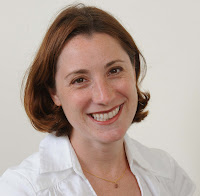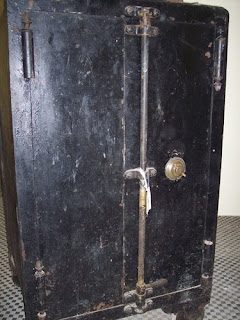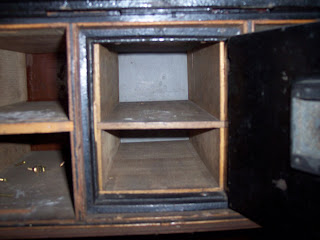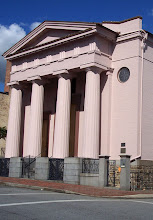Photo courtesy of board member Duke Zimmerman.
Wednesday, October 28, 2009
Lloyd Street Synagogue and LEGOs?
Photo courtesy of board member Duke Zimmerman.
Monday, October 26, 2009
Waah!
I miss the interns! And it’s not just because I need someone to flip my desk calendar (time has frozen since August 19th),
 to file my closed-out loan folders (a nice big pile is mounting – see the pencil pup for reference!), and to make phone calls to lenders about retrieving their materials!
to file my closed-out loan folders (a nice big pile is mounting – see the pencil pup for reference!), and to make phone calls to lenders about retrieving their materials!

I miss all of their energy and enthusiasm; their delight as they discover fun, interesting (and sometimes bizarre) items in the collection; the pencil competitions; conversations at the picnic tables outside…
Sure, interns take a lot of time and work: staff has to train them to be the little collection managers/curators/educators of tomorrow. We need to answer questions that often seem self explanatory (but only until we realize we’ve been doing our job for years and it really ISN’T that obvious!), try and arrange for cool field trips and remember to bring in the occasional snack. But interns help us be more efficient, more productive and better behaved (we have to set a good example you know!).
Who is going to scan that photo for the next issue of Generations magazine? Who is going to help put together the packets for the board retreat? Who will run downstairs and complete object measurements? Who will eat all of these delicious cupcakes…?
My piles have grown, the data entry is mounting, and there are projects just itching to be worked on. Bottom line: we need a few hardy interns to brave
Interested? (And why wouldn’t you be!?!) Send me, Jobi Zink, Senior Collections Manager and official Intern wrangler, an email at jzink@jewishmuseummd.org, and let’s talk!
Thursday, October 8, 2009
Student Immigration Stories
One more day to eat in the Sukkah!
New Cemetery Resources!
Cemetery burial listings are now available on-line for Rosedale, Beth Jacob-Finksburg Cemetery, Beth Tfiloh Cemetery, Mikro Kodesh-Beth Israel, Other East Baltimore cemeteries, West Baltimore cemeteries, Chevrah Ahavas Chesed, Cumberland Eastview Cemetery, and Frederick, Maryland!
Our family history collection at the Robert L. Weinberg Family History Center contains many additional primary source materials, including:
- Baltimore Jewish Times obituaries, 1919 to present
- Jack Lewis Funeral Home records, 1924-1939, 1956-1965
- Published and unpublished genealogies of Maryland Jewish families
- Baltimore City directories on microfiche/film, 1752-1930 (some years missing)
- U.S. manuscript census, Baltimore and other parts of Maryland, 1900, 1910, 1920, 1930
- Passenger index for ships that arrived in the Port of Baltimore, 1820-1952
- Passenger manifests of ships that arrived in the Port of Baltimore, 1840-1920
- Memoirs of Jewish Life in Maryland and Europe
- Records of Jewish cemeteries in the Greater Baltimore area
- Circumcision (1836-1870, 1940-1967), midwife (1892-1919) , and marriage (1850-1944) records of individual Baltimore-area mohels, midwives and rabbis
- H.I.A.S. arrival records (1911-1914, 1938-1953)
- Historical Database of Baltimore Religious Personnel
- Yizkor (Memorial) books of East European towns
- Hebrew Orphan Asylum records, 1873-1917
- Registries of Maryland military personnel in World Wars I and II
Additional resources include: archival collections from several Baltimore-area synagogues; records of local Jewish agencies, institutions and businesses; personal papers of prominent individuals; profiles of individuals and families in A History of the Jews of Baltimore (Blum, 1910) and other locally-published books; biographical, institutional and subject files related to Baltimore and Maryland Jewry; and oral histories of Maryland Jews. Periodicals that offer information on Maryland Jewry include the Baltimore Jewish Times (1919 to present), Jewish Comment (1895-1918), Jewish Chronicle (1875), Jewish Exponent (1887-1888), Sinai (1856-1860), Generations (1978 to present) and American Jewish Year Book (1899-1985). We also maintain a photograph collection related to immigration, Jewish life in Maryland, and the many institutions of Baltimore Jewry.
Our library contains publications on Jewish genealogy, including Shtetl Finder, Where Once We Walked, A Dictionary of Jewish Surnames From the Russian Empire, Jewish Roots in Poland, and the periodical Avotaynu. We also maintain a collection of publications and newsletters from genealogical societies across the nation.
To find out more, please contact our historian, Deb Weiner, at 410.732.6400 x224 or dweiner@jewishmuseummd.org.
Friday, October 2, 2009
Your Secret is Safe with Me!
 Tuesday morning a safe cracker came to the Lloyd Street Synagogue to open the enormous old safe in the basement and I got to watch!
Tuesday morning a safe cracker came to the Lloyd Street Synagogue to open the enormous old safe in the basement and I got to watch!

The cast iron concrete-insulated safe likely dates between 1880-1920. It doesn’t have manufacturers markings, but the expert thinks that it could be either Miller or York, two companies that were making this type of safe at the turn of the last century. My goal was to see what was saved inside so we could decide what to do the safe. If it held great treasures from Baltimore Hebrew Congregation or

The safe cracker quickly ascertained that the lock was in the open position but the door still seemed to be sealed tight. Using a crow bar and a block of wood for leverage it took him about 5 minutes to pry the heavy door open. Someone was serious about protecting the contents of the safe – the door had five insulated layers and an interior door!

My fingers were tingling with anticipation as the safe cracker opened these also unlocked doors. There were two rows of small cubby holes at the top of the safe and a big open section below. And everything was empty! No important minute books, no bills of sale, no bodies!

So, if this were a mystery novel we would know that someone else had already opened the safe. We’d have to backtrack and do research to figure out who beat us to the punch! – and find out what had been locked inside! Now I just have to figure out a way to get ‘the beast’ out of the basement.






